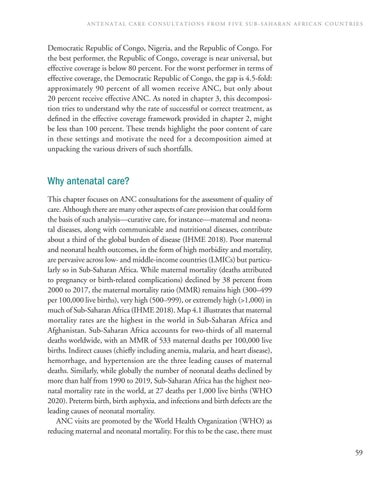A ntenatal C are C onsultations from F ive S ub - S aharan A frican C ountries
Democratic Republic of Congo, Nigeria, and the Republic of Congo. For the best performer, the Republic of Congo, coverage is near universal, but effective coverage is below 80 percent. For the worst performer in terms of effective coverage, the Democratic Republic of Congo, the gap is 4.5-fold: approximately 90 percent of all women receive ANC, but only about 20 percent receive effective ANC. As noted in chapter 3, this decomposition tries to understand why the rate of successful or correct treatment, as defined in the effective coverage framework provided in chapter 2, might be less than 100 percent. These trends highlight the poor content of care in these settings and motivate the need for a decomposition aimed at unpacking the various drivers of such shortfalls.
Why antenatal care? This chapter focuses on ANC consultations for the assessment of quality of care. Although there are many other aspects of care provision that could form the basis of such analysis—curative care, for instance—maternal and neonatal diseases, along with communicable and nutritional diseases, contribute about a third of the global burden of disease (IHME 2018). Poor maternal and neonatal health outcomes, in the form of high morbidity and mortality, are pervasive across low- and middle-income countries (LMICs) but particularly so in Sub-Saharan Africa. While maternal mortality (deaths attributed to pregnancy or birth-related complications) declined by 38 percent from 2000 to 2017, the maternal mortality ratio (MMR) remains high (300–499 per 100,000 live births), very high (500–999), or extremely high (>1,000) in much of Sub-Saharan Africa (IHME 2018). Map 4.1 illustrates that maternal mortality rates are the highest in the world in Sub-Saharan Africa and Afghanistan. Sub-Saharan Africa accounts for two-thirds of all maternal deaths worldwide, with an MMR of 533 maternal deaths per 100,000 live births. Indirect causes (chiefly including anemia, malaria, and heart disease), hemorrhage, and hypertension are the three leading causes of maternal deaths. Similarly, while globally the number of neonatal deaths declined by more than half from 1990 to 2019, Sub-Saharan Africa has the highest neonatal mortality rate in the world, at 27 deaths per 1,000 live births (WHO 2020). Preterm birth, birth asphyxia, and infections and birth defects are the leading causes of neonatal mortality. ANC visits are promoted by the World Health Organization (WHO) as reducing maternal and neonatal mortality. For this to be the case, there must 59

